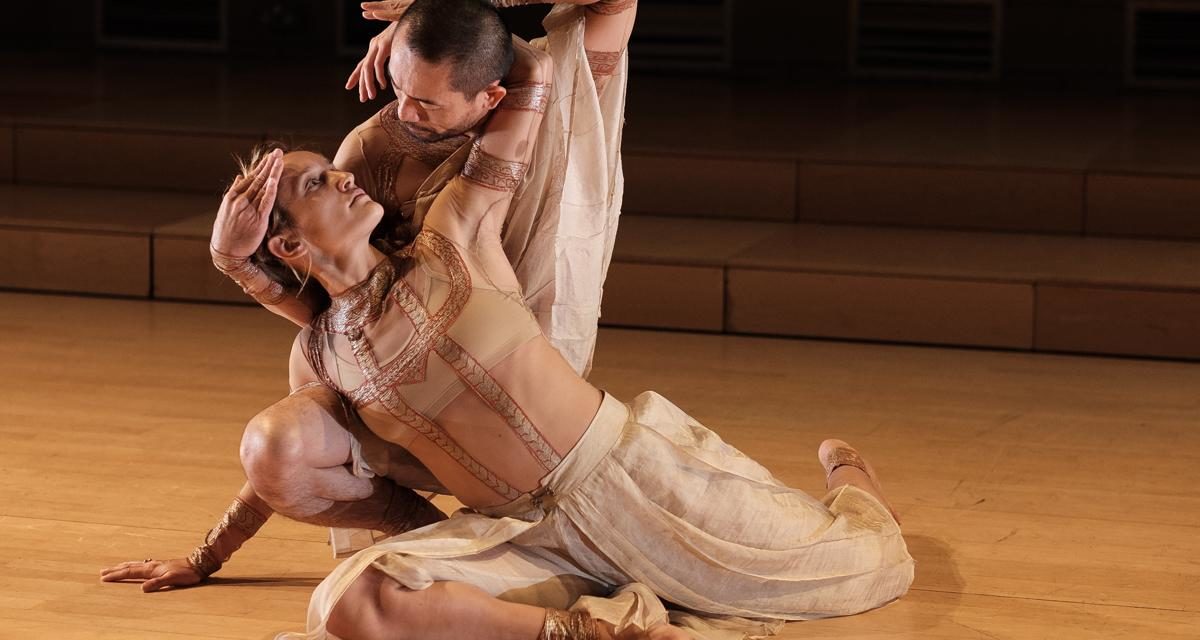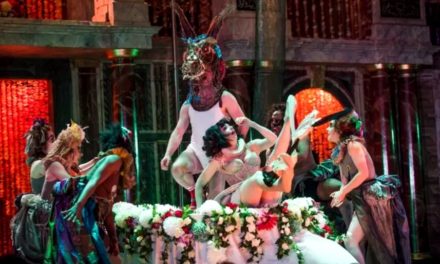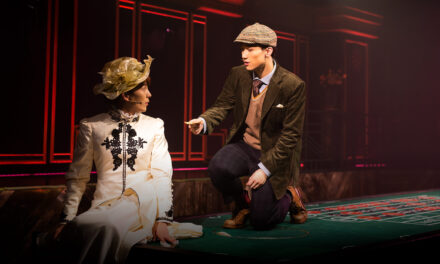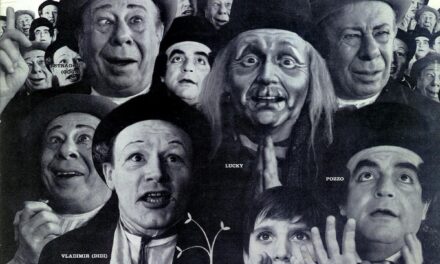“When I collaborate, I want to collaborate with the wrong person.”
Pichet Klunchun, Thai dancer, and director reveals a glint of mischief behind his earnest and gentle demeanor.
“I am looking for misunderstandings, for opportunities to negotiate. When things are wrong, they are right.” [1]
When I was initially brought as a dramaturg into the Mahajanaka Dance Drama project, directed by composer Sebastian Reynolds and choreographer Adrienne Hart (Neon Dance), in collaboration with Klunchun and Thai musicians Pradit Saengkrai and Great Lekakul, we began by asking “how can we tell a story from the Buddhist mythology using traditional Thai and contemporary Western art forms?”
Mahajanaka Dance Drama is a retelling of one of the Jataka stories, a set of myths about the previous lives of the Buddha. Originally Indian, the stories have different versions across Buddhist traditions, including the Thai tradition.
The catalyst for the collaboration came from Reynolds’ long-standing engagement with Buddhist culture in the UK, and visits to Thailand to learn about the Thai dance and music tradition. Work on Mahajanaka Dance Drama began when Hart and Reynolds traveled to Bangkok to meet Klunchun, Saengkrai, and Lekakul, and initiated the conversations that would lead to this intercultural and multi-artform collaboration.
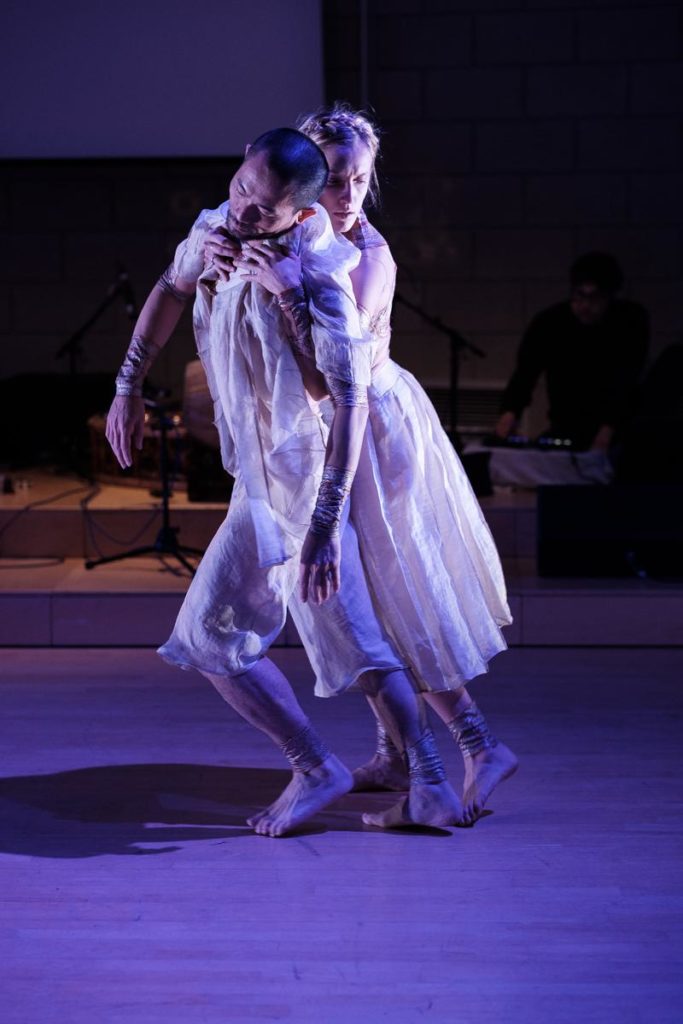
Photo Credit: Oliver Holms
The story of Prince Mahajanaka is told through Thai dance and music, which is traditionally performed as part of temple rituals to provide an offering of dance and music to the gods. The creative team were interested in how they could use traditional and Western cultural forms to revisit the story and open it to a new audience, or at least within a new context.
But this project is not a simple coming together of two cultural traditions to jointly tell a tale. Reynolds’ prior knowledge of the Thai Buddhist tradition, and engagement with the literature of the Jatakas through collaboration with scholar and Jataka translator Dr. Sarah Shaw, allowed him to bring considerable expertise to the collaboration. Indeed, as the collaboration began, discussion emerged about the existing historical Western (French) influences on the “traditional” Thai forms, complicating a superficially easy-to-tell story about “East meets West.”
Klunchun, who directs not only his own company but also his own theatre in Bangkok, doesn’t exactly toe the Thai traditional dance line himself. He describes his work as speaking the language of traditional dance but with the “wrong grammar.” He wants to move away from dance that describes something (such as the story of Prince Mahajanaka), towards dance that sparks the audience’s imagination.
Similarly, Saengkrai and Lekakul are both interested in working with traditional instruments, but not necessarily using them in the “correct” (traditional, acceptable) way. Reynolds worked with the two musicians to create an electronic score, which is performed live alongside a traditional “Piphat” ensemble of gong circle, Pi (Thai oboe), and other wind and percussion instruments.
In the work, Klunchun dances the role of the Prince Mahajanaka, using elements of the traditional Thai dance in his choreography. This includes the famous “swimming” scene, a seven-minute meditative solo, to represent the seven days and nights Mahajanaka spends in the ocean before being rescued by the goddess Mekele. Tilly Webber, a Western contemporary trained dancer, performs the roles of the Prince’s mother, the goddess Mekele and the Queen Sivali. Each dancer began creating their movement using their own language to explore the emotions of their characters, depicting key scenes and concepts in the story; but in the final choreography these dance forms overlap, intersect, and quote each other throughout the piece.
When I started working on this project, the structure and content of the work were more or less formed. My role was to think alongside Hart and Reynolds about how this piece would be received by an audience. An early question, which accompanied all our discussions, was how an audience’s prior knowledge would change their reception of the work, and how relevant the individual cultural background of an audience member would be.
As a dramaturg, as well as engaging with what goes into a work, I draw a director’s attention to what I see coming out of the work. But I don’t, as a rule, imagine that I can represent the audience–after all, I don’t know how any individual audience member might react to what they see on stage.
However, for this particular project, it was difficult to avoid an engagement with the question of different kinds of audiences. We knew that people who were familiar with Thai dance and music, and/or the story, would almost certainly have quite a different response to the work than an audience with no knowledge of these elements. At the same time, we couldn’t assume that there was one “Thai” or “South Asian” audience, and one “Western” audience. We didn’t want to be limited by this “problem,” but it created a point of focus to which I kept returning.
As a non-Thai, non-Buddhist Western dramaturg trained in contemporary Western art practice, I also needed to ask myself how I could help shape this piece in its preparation for an audience. In the broad tradition of the dramaturg’s work, there can be an expectation of the dramaturgical role as “translating” meaning. For example, Nanako Nakajima describes her role with artist koosil-ja in the framework of her expertise of the Japanese noh tradition. She notes how, as dramaturg, she became a mediator between this traditional Japanese artform and a post-modern contemporary Western art practice. [2]
My role in the Mahajanaka collaborative process was necessarily quite different, as I do not hold cultural knowledge of the subject matter. Neither I nor the collaborators intended my role as dramaturg to include being a mediator or translator of one form of knowledge into a new context.
But I still came back to the question of how I can predict what people in the audience do or don’t know. In what way could this work can have an identity which is a coherent event without specific knowledge of Thai or Buddhist culture?
Klunchun speaks about adding layers to the traditional Thai dance representation of the myth, and for that matter to the story itself. As a dance-maker, he understands himself to be making a new language in dance. He describes dance as having gestural and abstract languages that are present. The gestures have a meaning attached, the abstract language “makes me [the audience member] imagine something.”
By adding the collaborators’ responses to versions of the story, and versions of the language of Thai dance and music, Klunchun implies, we don’t lose the origin of the story within its cultural context, but instead are adding new layers of story, layers of meaning, using new and intersecting languages. It sounds like a continuation to his ongoing practice of re-configuring the grammar of Thai dance.
In rehearsals, we would often have robust discussions about these matters, and questions of representation of the core ideas underlying the story and the work–ideas which stem from a Buddhist tradition. With a range of cultural knowledge, expertise and languages in the room, we liberally skipped past the potentially restrictive angst about who is licensed to play with cultural traditions.
The ethical consideration, for me, was about how and why this work had meaning for the Western directors, and the (predominantly) Western audience that will encounter it at least initially. What I discovered in this process was an environment in which respect for and knowledge of cultural tradition were equally important to each collaborator. Simultaneously, everyone in the room was open to a playfulness, even a sense of mischief, that kept us all interrogating the work and its meaning throughout the layers we were all adding.
The collaboration might be, on paper, “wrong,” but with the depth of understanding and questioning which Klunchun and all the collaborators brought into the process, it definitely felt right to me.
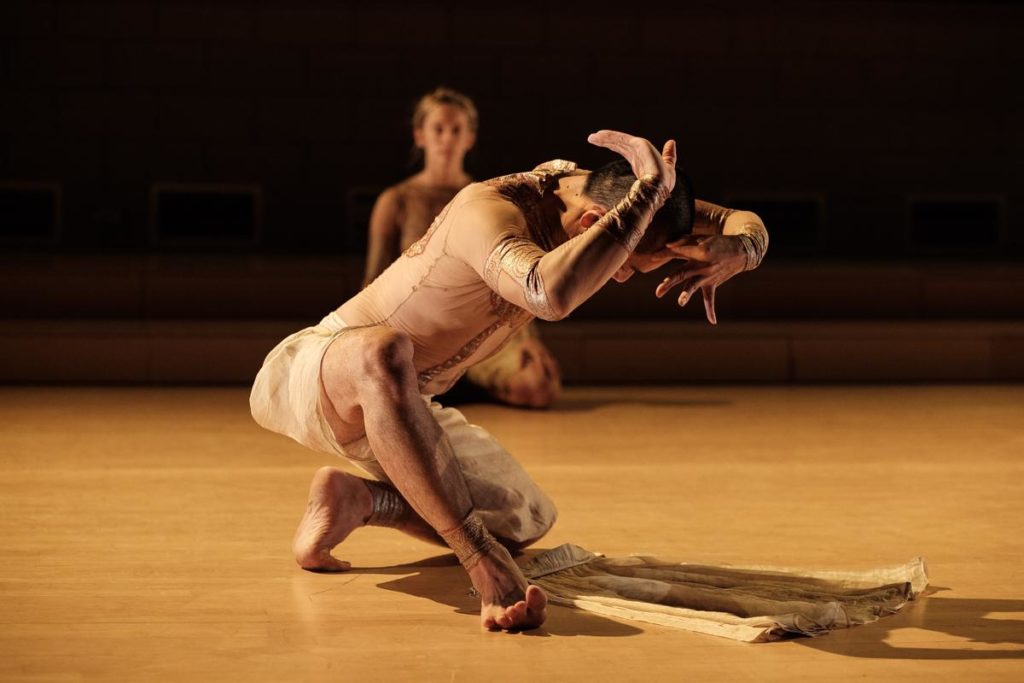
Photo Credit: Oliver Holms
September 2018
Mahajanaka Dance Drama was supported by Arts Council England, British Council, DanceXchange, Oxford Dance Forum, and Oxford City Council’s Culture Fund and first previewed at Wiltshire Music Centre on 2 April 2018. It is due to tour the UK and Thailand in 2019.
Notes:
[1] I paraphrase, only slightly
[2] Nanako Nakajima, ‘Dance Dramaturgy as a Process of Learning: koosil-ja’s mech[a]OUTPUT’ in Pil Hansen & Darcey Callison (eds): Dance Dramaturgy – Modes of Agency, Awareness and Engagement (Palgrave Macmillan, 2015)
Miranda Laurence is a freelance dance dramaturg based in the UK. She has been awarded a grant from Arts Council England for professional development as a dance dramaturg in 2017-18. She works with dance artists across the UK and also internationally (most recently with Finnish choreographer Johanna Nuutinen, enabled by a Collaborate award from South East Dance).
Miranda has also directed the ‘Dance & Academia’ project based in Oxford since 2008, convening a number of seminars and conferences engaging movement practitioners and academics in many different disciplines.
Alongside her freelance practice, Miranda is employed as Arts Development Officer at Reading University, where she is devising an arts strategy for the university.
This post was written by the author in their personal capacity.The opinions expressed in this article are the author’s own and do not reflect the view of The Theatre Times, their staff or collaborators.
This post was written by Miranda Laurence.
The views expressed here belong to the author and do not necessarily reflect our views and opinions.

